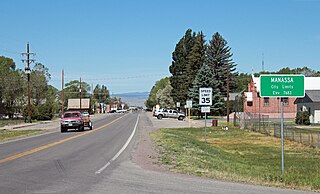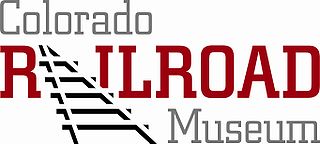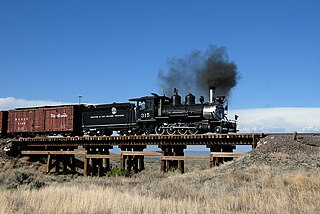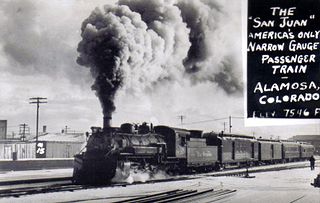
The Denver and Rio Grande Western Railroad, often shortened to Rio Grande, D&RG or D&RGW, formerly the Denver & Rio Grande Railroad, was an American Class I railroad company. The railroad started as a 3 ft narrow-gauge line running south from Denver, Colorado, in 1870. It served mainly as a transcontinental bridge line between Denver and Salt Lake City, Utah. The Rio Grande was also a major origin of coal and mineral traffic.

Founded in 1851, the Town of Manassa is a Statutory Town and is the most populous municipality in Conejos County, Colorado, United States. The town's population was 947 at the 2020 United States Census.

A dome car is a type of railway passenger car that has a glass dome on the top of the car where passengers can ride and see in all directions around the train. It also can include features of a coach, lounge car, dining car, sleeping car or observation. Beginning in 1945, dome cars were primarily used in the United States and Canada, though a small number were constructed in Europe for Trans Europ Express service.

The Cumbres and Toltec Scenic Railroad, often abbreviated as the C&TSRR, is a 3 ft narrow-gauge heritage railroad that operates on 64 miles (103 km) of track between Antonito, Colorado, and Chama, New Mexico, in the United States. The railroad is named for two geographical features along the route: the 10,015-foot (3,053 m)-high Cumbres Pass and the Toltec Gorge. Originally part of the Denver and Rio Grande Western Railroad's narrow-gauge network, the line has been jointly owned by the states of Colorado and New Mexico since 1970. Today, the C&TSRR is one of only two remaining parts of the former D&RGW narrow-gauge network, the other being the Durango and Silverton Narrow Gauge Railroad (D&SNG), which runs between the communities of Durango and Silverton, Colorado. The railroad has a total of ten narrow-gauge steam locomotives and two narrow-gauge diesel locomotives on its current roster. The railroad also operates two smaller former D&RGW steam locomotives, Nos. 315 and 168, for special events and excursions.

The Durango and Silverton Narrow Gauge Railroad, often abbreviated as the D&SNG, is a 3 ft (914 mm) narrow-gauge heritage railroad that operates on 45.2 mi (72.7 km) of track between Durango and Silverton, in the U.S. state of Colorado. The railway is a federally-designated National Historic Landmark and was also designated by the American Society of Civil Engineers as a National Historic Civil Engineering Landmark in 1968.

The Colorado Railroad Museum is a non-profit railroad museum. The museum is located on 15 acres (6.1 ha) at a point where Clear Creek flows between North and South Table Mountains in Golden, Colorado.

The Mount Hood Railroad is a heritage and shortline freight railroad located in Hood River, Oregon, 60 miles (97 km) east of Portland, Oregon, United States.

The Colorado Pacific Rio Grande Railroad is a class III railroad operating in south-central Colorado. It runs on 154 miles (248 km) of former Denver and Rio Grande Western Railroad tracks on three lines radiating from Alamosa and interchanges with the Union Pacific Railroad in Walsenburg. Much of the railroad is located in the San Luis Valley. In 2022, it was purchased by Stefan Soloviev.

The Southern San Luis Valley Railroad is a fallen flag shortline railroad that was located in Southern Colorado. Best known in its final years of operation, it served a connection with the Denver and Rio Grande Western Railroad at Blanca, Colorado. The diminutive railroad in its final form was approximately 1.53 miles (2.46 km) in length. During its life freight traffic included farm produce, fertilizer and volcanic scoria. The railroad, as it was originally built, was 31 miles (50 km) long and besides freight it operated passenger service between Blanca and Jaroso, Colorado, until 1946. The railroad formally ceased all operations December 31, 1996.
The Chili Line, officially known as the Santa Fe Branch, was a 3 ft narrow-gauge branch of the Denver and Rio Grande Western Railroad (D&RGW). It ran 125.6 miles (202.1 km) from Antonito, Colorado, to Santa Fe, New Mexico. The Denver and Rio Grande Railway (D&RG) began construction of the line in 1880 and completed the line from Antonito to Española, New Mexico, but could not build any further because of an agreement with the Atchison, Topeka and Santa Fe Railroad (AT&SF). The Texas, Santa Fe and Northern Railroad was incorporated to complete the line, and the line between Española and Santa Fe opened in 1886 and was transferred to the Denver and Rio Grande shortly thereafter. The D&RGW closed the Chili Line in 1941 because of competition from road transportation, and the line was abandoned shortly thereafter.

Denver and Rio Grande Western No. 315 is a class "C-18" 2-8-0 "Consolidation" type narrow-gauge steam locomotive that was originally built for the Florence and Cripple Creek Railroad by the Baldwin Locomotive Works in 1895. It was purchased by the Denver and Rio Grande Railroad (D&RG) in 1917 and later became known as No. 315. It was retired in 1949 and had been on display at City of Durango parks until the Durango Railroad Historical Society restored the locomotive from 2001 to August 2007. It was operational from then until September 2021. On March 8, 2023, it has returned to service, following its FRA federally mandated 1,472-day boiler inspection and overhaul. Most "sister" locomotives to No. 315 were scrapped, but two others survive today such as is D&RGW No. 318 and F&CC No. 10. No. 318 is on display at the Colorado Railroad Museum and F&CC No. 10 is currently in storage at the Nevada Southern Railroad Museum.

Denver and Rio Grande Western No. 168 is a class "T-12" 4-6-0 “Ten Wheeler” type narrow-gauge steam railway locomotive. It is one of twelve similar locomotives built for the Denver and Rio Grande Railroad (D&RG) by the Baldwin Locomotive Works in 1883. It was built as a passenger locomotive, with 46 in (1,200 mm) drivers, the largest drivers used on any three foot gauge D&RGW locomotive. The large drivers made it suitable for relatively fast passenger service.

Cumbres and Toltec Scenic Railroad No. 463 is a 3-foot narrow-gauge class "K-27" 2-8-2 "Mikado" type steam railway locomotive built for the Denver and Rio Grande Railroad (D&RG) by the Baldwin Locomotive Works in 1903. It is one of two remaining locomotives of D&RGW class K-27, the other one being No. 464 at the Huckleberry Railroad in Genesee Township, Michigan. The class eventually became known by the nickname "Mudhens". Today, No. 463 is operational on the Cumbres and Toltec Scenic Railroad between Chama, New Mexico and Antonito, Colorado.

The San Juan Express was a narrow gauge train that ran on the 3 feet (0.91 m) Denver & Rio Grande Western Railroad (D&RGW) route from Durango, Colorado via Chama, New Mexico; Cumbres Pass; and Antonito, Colorado to Alamosa, Colorado. The train ran from February 11, 1937 until January 31, 1951 as train numbers 115 and 116, though towards the end of the passenger service it took on the number 215 and 216.

La Veta Pass is the name associated with two nearby mountain passes in the Sangre de Cristo Mountains of south central Colorado in the United States, both lying on the boundary between Costilla and Huerfano counties.

The Alamosa–Durango line or San Juan extension was a railroad line built by the Denver and Rio Grande Western Railroad, following the border between the U.S. states of Colorado and New Mexico, in the Rocky Mountains. The line was originally built as a 3 ft narrow-gauge line between Alamosa, Colorado, and Durango, Colorado. Portions of the route survive: the now standard-gauged segment from Alamosa to Antonito, Colorado, and a narrow-gauge portion from Antonito to Chama, New Mexico.

The Colebrookdale Railroad, also known as the Secret Valley Line or colloquially as The Colebrookdale, is a tourist railroad located in the U.S. state of Pennsylvania. The railroad operates between Boyertown in Berks County and Pottstown in Montgomery County.

Lake Superior and Ishpeming Railroad No. 18 is an SC-4 class 2-8-0 “Consolidation” type steam locomotive, built by ALCO’s Pittsburgh Works in 1910 for the Lake Superior and Ishpeming (LS&I) Railroad in Upper Michigan. Originally numbered 11, the locomotive was renumbered to 18 in 1924, and it served the railroad, until it discontinued steam operations in 1962. No. 18 was subsequently sold to the Marquette and Huron Mountain tourist railroad, where it was put into storage alongside other steam locomotives.

Southern Pacific No. 1744 is a preserved American class "M-6" 2-6-0 "Mogul" type steam locomotive built by the Baldwin Locomotive Works for the Southern Pacific Railroad in November 1901. Originally equipped with Vauclain compound cylinders, it was rebuilt with conventional cylinders in 1912. It operated for many years out of Oakland, California on the Southern Pacific's Western Division and in California's Central Valley where the locomotive and its classmates were fondly called “Valley Mallets” by their crews. The locomotive was made famous in later years by pulling some of the last steam excursions on the SP alongside other steam locomotives, including 4-8-4 4460. In 1959, No. 1744 was donated to the Sons of Utah Pioneers in Corinne, Utah where it remained on static display, until 1980. That year, it was restored by New London Railroad and Village Incorporated to operate on the Heber Valley Railroad in Heber City for the rest of the decade.



















